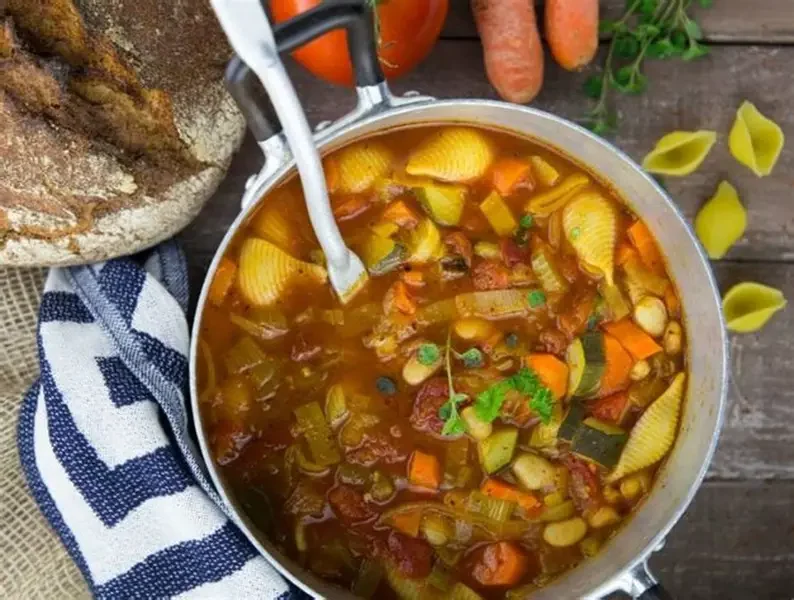Minestrone soup is the ultimate comfort food, a hearty Italian classic that blends vegetables, beans, pasta, and herbs into one nourishing pot. What I love most about minestrone is that it’s not a strict recipe—it’s a celebration of whatever fresh produce you have on hand, simmered slowly until everything comes together in a cozy harmony.
I still remember my first bowl of minestrone vividly. I was traveling in Florence, and after a long day of wandering cobblestone streets, I stumbled into a tiny trattoria. The aroma of simmering tomatoes and herbs filled the air, and the owner insisted I try their minestrone. One spoonful felt like a hug—warm, wholesome, and deeply satisfying. Since then, minestrone has become my go-to dish on chilly evenings or when I need a little comfort in a bowl.
Why This Recipe Is the Best
This minestrone recipe is special because it balances tradition with flexibility. It’s hearty without being heavy, packed with flavor, and easily adaptable for all diets. Whether you’re vegetarian, vegan, or just looking for a way to sneak more vegetables into your meals, this recipe has you covered. The combination of beans, pasta, and vegetables makes it filling enough to stand on its own, while the herbs and seasonings give it that signature Italian soul.
Ingredients (with Substitution Options)
- 2 tablespoons olive oil (or avocado oil for a lighter option)
- 1 onion, diced
- 2 carrots, diced
- 2 celery stalks, diced
- 3 garlic cloves, minced
- 1 zucchini, chopped (swap with yellow squash if preferred)
- 1 potato, peeled and cubed (sweet potato works too)
- 1 cup green beans, trimmed and cut into 1-inch pieces
- 1 can (14 oz) diced tomatoes (fresh tomatoes if in season)
- 6 cups vegetable broth (chicken broth for non-vegetarian option)
- 1 can (15 oz) cannellini beans, rinsed (kidney beans or chickpeas work well too)
- 1 teaspoon dried oregano
- 1 teaspoon dried basil
- 1 bay leaf
- Salt and black pepper to taste
- 1 cup small pasta (like ditalini, elbow, or shells; gluten-free if needed)
- 2 cups fresh spinach or kale (optional but recommended)
- Grated Parmesan for topping (or nutritional yeast for a vegan option)
Step-by-Step Instructions
- Sauté the base: In a large pot, heat olive oil over medium heat. Add onion, carrots, and celery. Cook for 5–6 minutes until softened.
- Build the flavor: Stir in garlic, zucchini, and potatoes. Cook for another 2 minutes until fragrant.
- Add the liquids and seasonings: Pour in diced tomatoes, vegetable broth, oregano, basil, bay leaf, salt, and pepper. Stir well.
- Simmer gently: Cover the pot and let it simmer for 20 minutes, until the vegetables begin to soften.
- Add beans and pasta: Stir in beans and pasta, then cook for another 10 minutes, until the pasta is tender.
- Finish with greens: Stir in spinach or kale and cook for 2–3 minutes, just until wilted.
- Serve warm: Ladle into bowls, top with grated Parmesan or a sprinkle of fresh herbs, and enjoy.
Tips for Perfect Minestrone
- Use seasonal veggies: Swap in whatever’s fresh—cabbage, peas, or even corn.
- Don’t overcook the pasta: Add it toward the end so it doesn’t turn mushy.
- For more depth of flavor: Add a Parmesan rind to the pot while simmering (remove before serving).
- Make it spicy: Add a pinch of red pepper flakes for a little kick.
Storage and Reheating
Minestrone is even better the next day! Store leftovers in an airtight container in the fridge for up to 4 days. If you plan to freeze it, cook the soup without pasta, then add freshly cooked pasta when reheating to avoid sogginess. It freezes beautifully for up to 3 months.
What type of pasta works best in minestrone soup?
Small pasta shapes like ditalini, elbows, or small shells are traditional and hold up well in the broth. If you only have larger pasta, break it into smaller pieces before cooking. The key is choosing a shape that doesn’t overwhelm the vegetables and beans.
How can I make this recipe gluten-free or vegan?
For a gluten-free version, simply use gluten-free pasta or swap the pasta with rice or quinoa. To keep it vegan, skip the Parmesan cheese and instead use nutritional yeast or a drizzle of good olive oil for that extra savory flavor.
